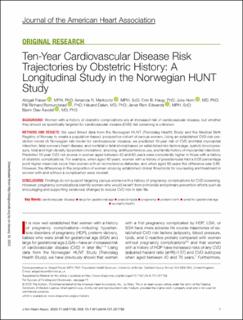| dc.contributor.author | Fraser, Abigail | |
| dc.contributor.author | Markovitz, Amanda R. | |
| dc.contributor.author | Haug, Eirin Beate | |
| dc.contributor.author | Horn, Julie | |
| dc.contributor.author | Romundstad, Pål Richard | |
| dc.contributor.author | Dalen, Håvard | |
| dc.contributor.author | Rich-Edwards, Janet Wilson | |
| dc.contributor.author | Åsvold, Bjørn Olav | |
| dc.date.accessioned | 2023-02-07T12:26:45Z | |
| dc.date.available | 2023-02-07T12:26:45Z | |
| dc.date.created | 2022-04-11T15:13:21Z | |
| dc.date.issued | 2022 | |
| dc.identifier.citation | Journal of the American Heart Association (JAHA). 2022, 11 (2), . | en_US |
| dc.identifier.issn | 2047-9980 | |
| dc.identifier.uri | https://hdl.handle.net/11250/3048884 | |
| dc.description.abstract | Background
Women with a history of obstetric complications are at increased risk of cardiovascular disease, but whether they should be specifically targeted for cardiovascular disease (CVD) risk screening is unknown.
Methods and Results
We used linked data from the Norwegian HUNT (Trøndelag Health) Study and the Medical Birth Registry of Norway to create a population‐based, prospective cohort of parous women. Using an established CVD risk prediction model (A Norwegian risk model for cardiovascular disease), we predicted 10‐year risk of CVD (nonfatal myocardial infarction, fatal coronary heart disease, and nonfatal or fatal stroke) based on established risk factors (age, systolic blood pressure, total and high‐density lipoprotein cholesterol, smoking, antihypertensive use, and family history of myocardial infarction). Predicted 10‐year CVD risk scores in women aged between 40 and 60 years were consistently higher in those with a history of obstetric complications. For example, when aged 40 years, women with a history of preeclampsia had a 0.06 percentage point higher mean risk score than women with all normotensive deliveries, and when aged 60 years this difference was 0.86. However, the differences in the proportion of women crossing established clinical thresholds for counseling and treatment in women with and without a complication were modest.
Conclusions
Findings do not support targeting parous women with a history of pregnancy complications for CVD screening. However, pregnancy complications identify women who would benefit from primordial and primary prevention efforts such as encouraging and supporting behavioral changes to reduce CVD risk in later life. | en_US |
| dc.language.iso | eng | en_US |
| dc.publisher | American Heart Association | en_US |
| dc.rights | Navngivelse-Ikkekommersiell 4.0 Internasjonal | * |
| dc.rights.uri | http://creativecommons.org/licenses/by-nc/4.0/deed.no | * |
| dc.title | Ten-Year Cardiovascular Disease Risk Trajectories by Obstetric History: A Longitudinal Study in the Norwegian HUNT Study | en_US |
| dc.title.alternative | Ten-Year Cardiovascular Disease Risk Trajectories by Obstetric History: A Longitudinal Study in the Norwegian HUNT Study | en_US |
| dc.type | Peer reviewed | en_US |
| dc.type | Journal article | en_US |
| dc.description.version | publishedVersion | en_US |
| dc.source.volume | 11 | en_US |
| dc.source.journal | Journal of the American Heart Association (JAHA) | en_US |
| dc.source.issue | 2 | en_US |
| dc.identifier.doi | 10.1161/JAHA.121.021733 | |
| dc.identifier.cristin | 2016791 | |
| cristin.ispublished | true | |
| cristin.fulltext | original | |
| cristin.qualitycode | 1 | |

